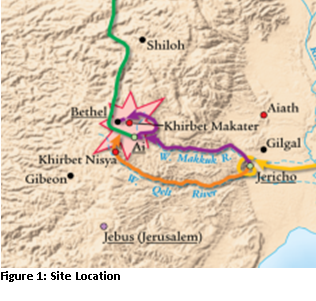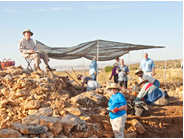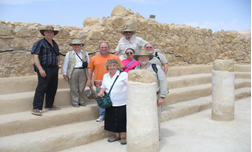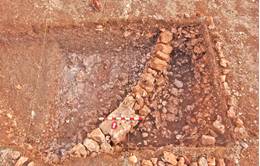Once the decision was made to participate on the dig, expectations began to build as to what the experience would be like. I began to talk about the trip to as many folks as possible describing my expectations and hopes concerning digging in the Promised Land. As with any preconceived expectations, there is always the possible of being disappointed. My trip to Maqatir was definitely not a disappointment. The expedition exceeded every desire and hope. What follows are my thoughts on being part of the excavation team at Maqatir in 2011.
But first, why excavate at Maqatir? Many secular and even some Christian scholars do not believe that there was a conquest of Ai as detailed in Joshua 7-8 around 1400 BC. They believe that Ai is located at et-Tell, about 1 km. east of Maqatir, where there was no occupation in 1400 BC, thus no conquest of Ai. To counter this understanding is the primary objective of this excavation. The Associates for Biblical Research was founded to take on the task of demonstrating that the secular scholars are wrong about the location of Ai. In simple terms, the secular scholars were looking for a site where there was no “destruction” level. Well, they found it at a site close to where we are excavating and a site that has the name of “Ai” that does not have a destruction level. With this determination they suggest that the scripture is incorrect.
I guess that I could start the article by talking about the weekend tour led by Dr. Scott Stripling to Masada, Qumran, Old and New Testament Jericho, and Jerusalem during our weekend off. But in many ways that would not reveal the experience of the dig itself and was some additional cherries on top of the wonderful dessert delivered by digging at Maqatir. All of these locations by themselves could easily be an article filled with archaeological evidences. Since many of these locations have been discussed in the pages of this magazine, I would invite you to read up on them within the pages of Bible and Spade.
It is important to understand that this trip was not like any of my previous trips to Israel. For one thing, the morning routine was definitely different. Getting up at 4:00 AM was not something I had done when I had been a tourist in Israel, traveling to Caesarea Maritima, the western wall, Bethlehem, and other locations in the country. But soon, the excitement of going to the site kicks in and you realize that you had better hurry and get to breakfast, so you can eat something and, o’ by the way, make a lunch to eat later in the day. Of course, you also better hurry, so that the bus that is ready to leave at 4:45 AM is not waiting for you to leave for the site. (See daily schedule).

But where is the dig site? Khirbet el Maqatir is basically out in the middle of nowhere; approximately 10 miles north of Jerusalem. Since we think that this is the locationn of the biblical site of Ai mentioned in the book of Joshua, you know that it has to be fairly close to Jericho. This map on the right shows where Khirbet el Maqatir is in relationship to Jericho and Jerusalem. This map also shows the location of the Khirbet Nisya site that has been suggested by ABR founder David Livingston as the site for the Joshua Ai. To get to the dig site from where the group was staying we had a bus ride of at least 40 minutes. During the bus ride, the group had time for a devotional led by various members of the excavation team.
Getting to the site is only a portion of the daily routine. Climbing up and then down a hill to get the opposite side was also part of the morning events, along with going to get the tools of the trade (picture below) from a nearby house. These tools are unique to the job or excavating in Israel and are used to rapidly remove the dirt; getting to the various stratigraphic levels that reveal occupational relics waiting to be removed and analyzed. But first, the site must be prepared. This is done with the raising of the sun screen tents (picture below) that shield us from the summer sun in Israel. Then the real action begins. What follows here is a journal of the experiences at Maqatir. Hopefully, this will generate some interest for folks to participate on the dig in future excavation seasons.


The Journal
23 May 2011 – One word … exhausted … describes my immediate thoughts. Not sure when I have worked as hard in quite some time. Sun, wind, and heat took its toll on the body, but there were some wonderful experiences. Once we got to the site, we had to first manhandle the tools of the trade to the site up and down a few hills. Getting everything to the excavation site took almost one hour just by itself! Finally, though, we were able to get started excavating and began by removing the top grass and thistles. Once we got through the top soil, we immediately found some pottery and part of a wall in the square that might date to the time of Joshua and the conquest period. This could be a significant item for reinforcing the historicity of the Bible! While there has not been much in the way of significant finds, this first day has been tiring but, more importantly, exhilarating because the dream that began a few months ago was coming true: “Digging in the Land of the Lord.” Once we got back to the retreat center where we were staying, we “washed” the pottery, rested, had supper, and then had a lecture from one of the staff members.

24 May 2011 - Today we continued to excavate around the “wall” we partially exposed yesterday (see left). The wall, composed of several layers of large rocks, seems to have been constructed to level out the ground. However, the purpose of this “wall” was currently not known. That is something that we will be looking into over the next few days. Pottery wise we have found many different types from the Middle and Late Bronze, Hellenistic and Roman periods all mixed together in the excavated dirt. Bottom line, we are working hard and making some significant progress with excavating the square that I am working. As we continue to work, I am continually reminded that we are trying to demonstrate that this is a historical biblical site: specifically the biblical site of Joshua’s Ai. Some of the pictures that I have taken are beginning to show the progress of the square excavation. We are still finding the same pottery types in the mixture of soil that we have been removing from the square.

25 May 2011 - Wow, what a day. No breeze to lessen the heat. Not sure exactly how hot, but it sure was hot. Drank much water and I have survived. During the lecture tonight, I was reminded that over the past many years, I have been working with Dr. Wood creating drawings of the pottery from the site. It was somewhat funny though, as we are looking at the lecture slides and discussing them, I began to think that the pictures looked familiar and all of a sudden I realized that they were some of the drawings I have made in the past. It was fun seeing those efforts reflected in some of the slides that we were seeing during the lectures. While all that was great, what is even more important is the excitement of seeing the pottery piece or other artifact that I had unearthed maybe becoming something that increases the evidence that the scripture is in fact true and reliable. This is lots of fun in many ways, but it sure is exhausting.
26 – 27 May 2011 - Today I worked with another member of the group on the paperwork concerning the various finds that we have been excavating. We cut the pottery sherds to get a cross section that provide a profiles of what the piece of pottery looked like. Then we traced on paper what the pottery profile looked like. This assists in identifying the time period from which the pottery was made and therefore what time the structure, feature, etc. associated with the pottery was created. This was tedious work, but very interesting, as I got to see all of the artifacts that had been excavated the previous days. So far, we have seen Roman, Byzantine, Iron, & Bronze period artifacts. Of real interest were the Late Bronze Period artifacts that indicate that the site was inhabited during the time of Joshua. We have also found some sling stones, Roman nails, mosaic tiles, roofing tiles, and much more. Lots of things to look at and analyze! This is really a lot of fun, so back to the site next week, but first some rest over the weekend. Participating with the pottery reading has been very educational, especially since I have been looking at drawings of the pottery from Maqatir for many years.
28 May 2011 – Well, there was not much rest today, as I visited Masada, Qumran, Jericho (N.T.), Jericho (O.T.), Jerusalem to visit the traditional place where Christ cried, and then to the top of Mt. Olives to view the Temple mount as the sun set in the west. What a beautiful site! Every place was filled with wonderful concepts and biblical ideas that I am sure will end up in the classes that I teach. I just hope that I can remember them when I get home.

29 May 2011 - I visited the Israel Museum and spent about four hours in the archaeology section and saw many of the artifacts that I studied in the past, such as the TAANCH stand, the Asherah burial inscription, and many more. We also visited the Shrine of the Book, where the Dead Sea scrolls are located and viewed many of the scrolls I have an interest in. Finally, we visited the museum store and as many of you might imagine I did spend some money there.
30 May 2011 - Today, it was back on to the site with that 4:00 AM wakeup call! We were short a few folks, so we did not accomplish as much today as we have been, but it was still a profitable day. One thing that has become critically important is to ensure that the pottery cleaning is done correctly and accurately. Unless the pottery is adequately cleaned, it is difficult to determine the type of pottery and most importantly, the time period. Finally, I have been learning how to become a “square supervisor” under the tutelage of Gary Byers and Jim Luther. What fun I am having! Well, this report marks the half way point. See many of you next week on Monday … that is, if I come back.

31 May 2011 – Today, we continued to excavate what we in the square are calling a Byzantine terrace wall in the hope of finding something else near the wall that is associated with the Middle Bronze Age. In other parts of the excavation, we have found a coin from the time just after Jesus Christ. We have also found a really neat Roman/Jewish Villa on the site. Overall the el Maqatir site has multiple occupation levels ranging from the time of Abraham to the Byzantine period. Having this many occupations makes excavation very hard as you have to totally understand the top level before you can understand what is below the level in each square. Still having fun, but I am extremely tired.
1 -2 June 2011 - Well we are starting to shut down the excavation season. My square was closed out yesterday and I did paper work in the morning and went to another square after lunch and did some paperwork there as well (See final picture on left). At a macro level, we have excavated a Byzantine church apse, a Roman villa complex from the time of Christ, a Byzantine (??) terrace wall (square I worked in), a Hellenistic site with two cisterns, and a pottery kiln. Much more can be said, but that will come in a final report that will be written by Dr. Wood. While there has been some disappointment with not finding significant artifacts related to the time of Joshua, this year’s excavation has revealed extremely interesting artifacts from other time periods.

The learning experience excavating at Maqatir has been really great and has provided many examples for me to use in the classroom and in other venues. Hopefully, this diary has been informative and I am already looking forward to participating in next year’s excavation. See you next year in Maqatir!!!!